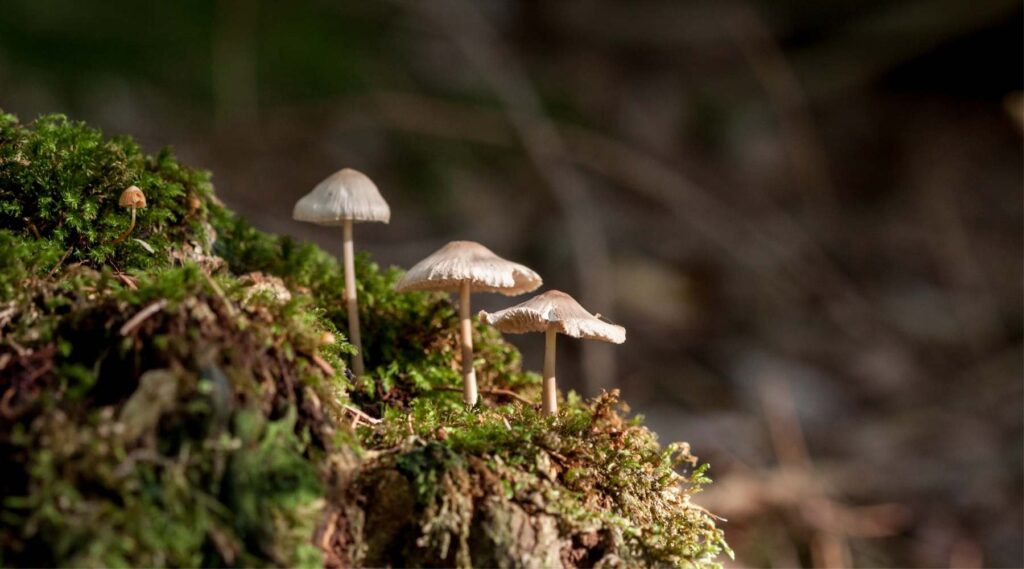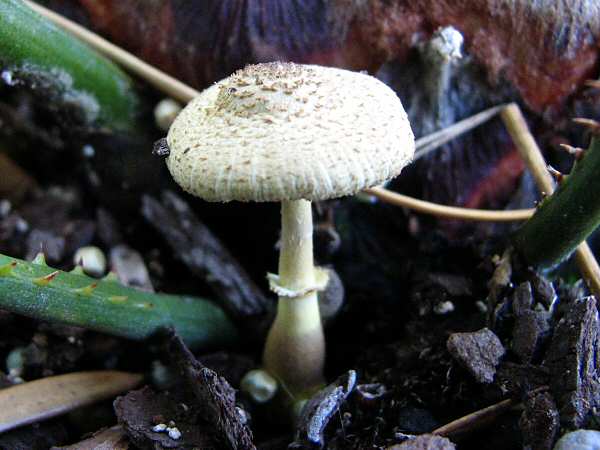To address mushrooms in your house, focus on eliminating the underlying moisture issue rather than trying to kill the mushrooms themselves. Mushrooms thrive in damp conditions, so identifying and fixing the source of moisture is crucial. This might involve repairing leaks, improving ventilation in moisture-prone areas, or using a dehumidifier to reduce humidity levels. If you have existing mushrooms, manually remove them and dispose of them in sealed bags, avoiding composting to prevent spore spread.
Clean the affected areas, and monitor for reoccurrence, continuing to address any moisture problems. Be cautious, as some indoor mushrooms can be toxic if ingested, and consult experts if needed.
How to identify the source of moisture in your home?

Identifying and addressing these common sources of excess moisture is a critical step in preventing mushrooms from growing in your house.
Recognizing the connection between moisture and mushroom growth
Mushrooms, as fungi, require moisture to grow. The presence of excess moisture provides an ideal environment for spores to germinate and form mushrooms.
High humidity levels and damp conditions create the perfect breeding ground for fungi, making it essential to recognize the direct link between moisture and mushroom proliferation.
Ignoring the moisture issue while attempting to eliminate mushrooms is likely to be ineffective, as they will continue to reappear unless the source of moisture is addressed.
Common sources of excess moisture
Leaky pipes and plumbing: Dripping or leaking pipes, whether hidden or visible, can introduce moisture into the structure of your house, encouraging mushroom growth.
Regularly inspect your plumbing system for any leaks, and promptly fix them to prevent ongoing moisture problems.
Roof leaks: Roof leaks can result from damaged shingles, flashing, or improper sealing around vents and chimneys.
Water infiltration from the roof can seep into walls and ceilings, creating a damp environment that mushrooms find favorable.
Poor ventilation: Inadequate ventilation in areas such as bathrooms, kitchens, and basements can trap humidity and moisture, promoting fungal growth.
Proper ventilation, through exhaust fans or open windows, helps maintain optimal indoor humidity levels and discourages mushroom development.
High humidity levels: Some regions or seasons naturally have high humidity, which can affect your indoor environment. This can create conditions that support mushroom growth.
Using a hygrometer to measure indoor humidity can help you determine if your home’s moisture levels are too high.
Water damage: Previous water damage incidents, such as flooding, can lead to residual moisture in building materials or within walls, providing a breeding ground for mushrooms.
Repair and remediate water-damaged areas thoroughly to prevent recurrent issues.
How to correct moisture problems in your house?
Correcting the moisture problem in your home requires a multi-faceted approach that addresses water leaks, ventilation, and humidity control.
Fixing water leaks and addressing water damage
Fixing water leaks, whether from plumbing or roofing, is essential to eliminate the source of excess moisture in your home.
Inspect your plumbing system regularly, including pipes, faucets, and connections, to identify and repair any leaks promptly. Similarly, address roof leaks by inspecting your roof and addressing any damaged areas.
When water damage occurs, it’s crucial to take immediate action. Water-damaged materials, such as drywall and insulation, can hold moisture and provide a conducive environment for mold and fungi, including mushrooms. Properly remediate and replace damaged materials to prevent ongoing issues.
Improving ventilation and airflow
Adequate ventilation helps disperse humidity and maintain a dry indoor environment, which is hostile to mushroom growth.
Focus on areas prone to moisture buildup, like bathrooms and kitchens. Ensure they have exhaust fans that efficiently remove humid air to the outside. In the absence of exhaust fans, opening windows can help improve airflow.
Additionally, consider cross-ventilation in your home, allowing fresh, drier air to circulate, reducing indoor humidity levels.
Using dehumidifiers to reduce humidity levels
Dehumidifiers are valuable tools for maintaining optimal indoor humidity levels. They work by drawing moisture from the air, effectively reducing humidity.
Place dehumidifiers in areas with persistent moisture problems, such as basements or crawl spaces, and set them to maintain a recommended indoor relative humidity level of around 30-50%.
Regularly empty the dehumidifier’s water tank and clean or replace filters as necessary to ensure its effectiveness.
How to deal with mushrooms in your home?
Dealing with existing mushrooms in your house requires a cautious approach to ensure the safe removal and disposal of the fungi.
Safely removing mushrooms
When you discover mushrooms in your home, it’s important to remove them carefully to prevent spore dispersion.
Wear gloves to avoid direct contact with the mushrooms, as some indoor mushroom species can be toxic.
Gently pluck the mushrooms at their base to remove them. Avoid disturbing the surrounding area, as this can release spores.
Place the collected mushrooms in a sealable plastic bag to contain any spores and minimize their spread.
Proper disposal methods
Disposing of mushrooms properly is crucial to prevent spores from contaminating other areas. Seal the plastic bag containing the mushrooms tightly to prevent spore release.
Dispose of the bag in your household trash. Do not compost the mushrooms, as this can spread spores and potentially lead to mushroom growth in your compost pile.
If you have concerns about toxicity or are uncertain about the type of mushroom, consider double-bagging them for extra safety.
Cleaning the affected areas
After removing the mushrooms, it’s essential to clean and sanitize the affected areas to eliminate any remaining spores.
Use a mixture of water and mild detergent to clean surfaces where the mushrooms were growing. Ensure thorough cleaning to remove any spores.
Let the area dry completely, as dry conditions are less favorable for fungal growth.
Inspect the cleaned area periodically to ensure that no new mushrooms are developing, and continue addressing any underlying moisture issues to prevent reoccurrence.
How to prevent future mushroom growth indoors?

Preventing future mushroom growth requires ongoing maintenance, vigilance, and proactive measures to maintain a moisture-free environment.
Monitoring for reoccurrence:
After addressing the immediate issue of mushroom growth, it’s important to stay vigilant and monitor the areas where mushrooms were previously found.
Regularly inspect these areas to check for any signs of reoccurrence. Keep an eye out for new mushroom growth, changes in moisture levels, or any visual cues that might indicate a return of the problem.
Early detection of reoccurrence is key to prompt intervention and preventing the issue from escalating.
Maintaining a moisture-free environment
Maintaining a moisture-free environment is the most effective way to prevent future mushroom growth.
Continuously address the sources of excess moisture in your home. Regularly inspect and maintain your plumbing system, roof, and ventilation systems to ensure they are in good working condition.
Be proactive about keeping indoor humidity levels in check. Use dehumidifiers in moisture-prone areas and consider investing in a hygrometer to monitor indoor humidity levels.
Ensure that water-damaged areas are repaired and dried thoroughly to prevent the recurrence of moisture-related issues.
Seeking professional help if necessary
If you’re unable to identify or effectively address the source of excess moisture in your home, or if you’re dealing with persistent mushroom problems, it may be necessary to seek professional assistance.
A plumber can help identify and repair hidden water leaks, while a roofing contractor can address roof-related issues.
If you’re uncertain about the type of mushrooms or the presence of toxic species, consult with a mycologist or a pest control expert for proper identification and guidance on safe removal.
FAQ’s
How do you kill mushroom mycelium?
Killing mushroom mycelium typically involves addressing the underlying cause, such as eliminating excess moisture.
How do you kill mushroom mold?
To address mushroom mold, you need to remove its source of moisture and improve ventilation to prevent further growth.
How do you stop mycelium from growing?
Stopping mycelium from growing involves controlling humidity, moisture, and providing proper ventilation in your environment.
Does water get rid of mycelium?
Water alone does not effectively get rid of mycelium; it requires addressing the underlying conditions that promote its growth.
How do you get rid of mycelia?
Getting rid of mycelia involves drying out the environment, improving airflow, and maintaining a moisture-free space.
What mushroom kills insects?
The entomopathogenic fungus, Beauveria bassiana, is known for its ability to kill insects and is used in some biopesticides.
Final Words
When it comes to dealing with mushrooms in your house, it’s essential to focus on tackling the root cause of the problem: excess moisture. Mushrooms thrive in damp conditions, so by identifying and addressing sources of moisture like leaks, improving ventilation, and using dehumidifiers, you can create an environment that’s less inviting to these fungi.
Once you’ve removed existing mushrooms safely and cleaned the affected areas, ongoing monitoring is important to catch any reoccurrence early.
